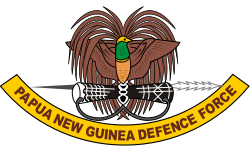Papua New Guinea Defence Force
| Papua New Guinea Defence Force |
|
|---|---|

Papua New Guinea Defence Force emblem
|
|
| Founded | 1973 |
| Service branches | Land Element Maritime Operations Element Air Operations Element |
| Headquarters | Murray Barracks, Port Moresby |
| Leadership | |
| The Minister for Defence | The Honourable Fabian Pok |
| Commander PNGDF | Brigadier General Gilbert Toropo |
| Manpower | |
| Military age | 20 |
| Available for military service |
1,568,210 males, age 16–49 (2010 est.), 1,478,965 females, age 16–49 (2010 est.) |
| Fit for military service |
1,130,951 males, age 16–49 (2010 est.), 1,137,753 females, age 16–49 (2010 est.) |
| Reaching military age annually |
67,781 males (2010 est.), 65,820 females (2010 est.) |
| Active personnel | 2,557 (2013) |
| Expenditures | |
| Budget | $US113.1 million (2014) |
| Percent of GDP | 1.9 (2014) |
The Papua New Guinea Defence Force (PNGDF) is the military organisation responsible for the defence of Papua New Guinea. It originated from the Australian Army land forces of the territory of Papua New Guinea before independence, coming into being in January 1973 and having its antecedents in the Pacific Islands Regiment. The PNGDF is a small force numbering around 2,500 personnel and consists of a Land Element, an Air Operations Element and a Maritime Operations Element. It is a joint force tasked with defending Papua New Guinea and its territories against external attack, as well as having secondary functions including national-building and internal security tasks.
Defence accounts for less than 2% of government expenditure, while also receiving significant assistance and training support from Australia, New Zealand, the United States and other nations. The Defence White Paper 2013 plans to increase the force to 5,000 personnel and double defence spending to 3% by 2017 and by 2030 have 10,000 personnel.
The PNGDF Land Element includes two infantry battalions, an engineer battalion, a signal squadron, an Explosive Ordnance Disposal (EOD) unit, and a preventive medicine platoon. The Air Operations Element is a small air wing operating a light transport aircraft and two leased helicopters. The Maritime Operations Element consists of four Pacific class patrol boats and two Balikpapan class landing craft. The army is under the direct command of Headquarters PNGDF, while the air wing and navy have their own commanding officers. The PNGDF does not have a Commander-in-Chief instead a Commander who advises the Minister for Defence. The PNGDF is under the control of the National Executive Council through the Minister for Defence.
The PNGDF originated from the Australian Army land forces of the Territory of Papua New Guinea before independence, coming into being in January 1973 and having its antecedents in the Pacific Islands Regiment. At independence it numbered 3,750 all ranks, while another 465 Australian personnel augmented the force to assist in training and technical support. In the mid 1990s, the PNG economy was in crisis with financial support provided by the World Bank and the International Monetary Fund (IMF) on the proviso of economic reform with the first phase in 1996 to include defence. Successive attempts to reduce the size of the PNGDF in response to the country's economic problems provoked fierce resistance. In 2000, the World Bank and the IMF provided loans with economic reform conditions and a Commonwealth Eminent Persons Group (CEPG) report recommended to government that the PNGDF strength be reduced by more than half. In March 2001, soldiers mutinied after learning the government had approved the CEPG report. The government capitulated after 10 days to the mutineers' demands, agreeing not to cut the army's strength. However, in 2002 it was announced that the PNGDF would be reduced from 4,000 to around 2,100 personnel. In early 2004 the government reaffirmed its commitment to implement cuts within the armed forces, with a definitive restructuring expected to take place. Chief of Staff Captain Aloysius Tom Ur told troops in January 2004 that the 2004 strength of 3,000 would be reduced by one-third, and that during 2004, the force's personnel branch would merge with the support branch into a new organisation. Ultimately the reduction-in-size target was reached in 2009.
...
Wikipedia
